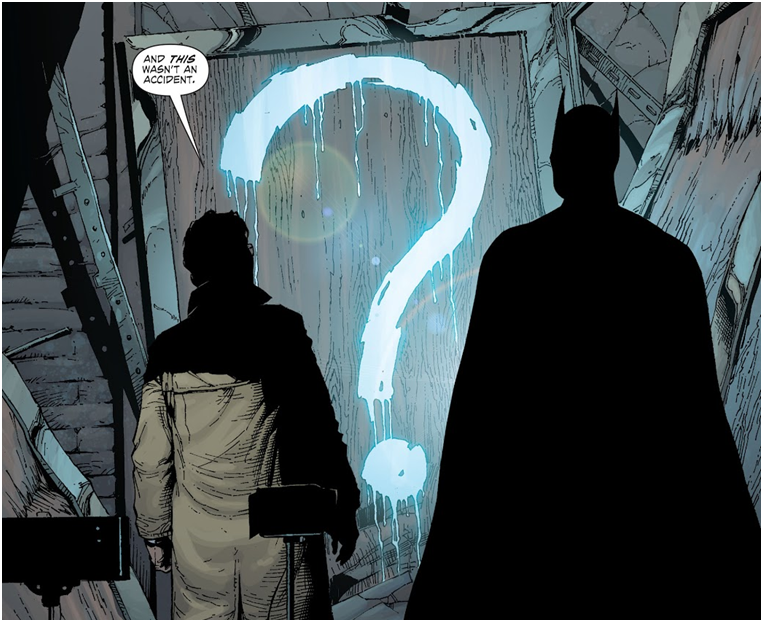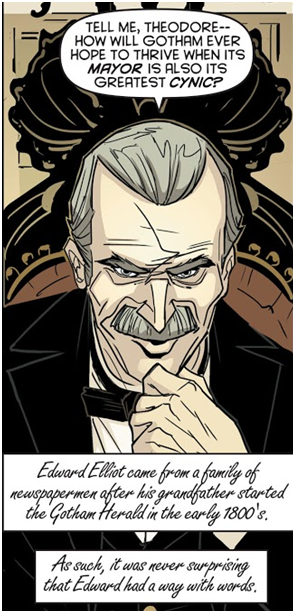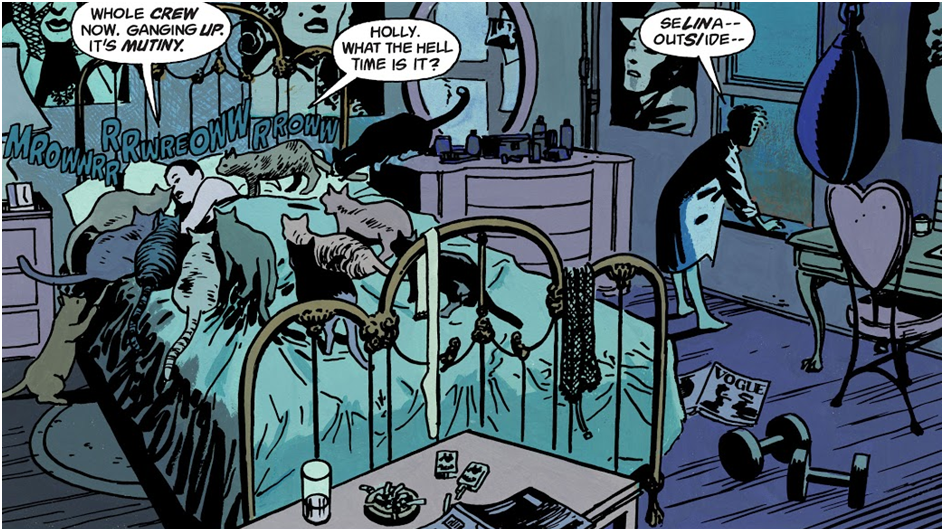Matt Reeves The Batman, starring Robert Pattinson in the titular role, was released this month. Now that we've seen the film we can explore the possible comic influences on this latest cinematic incarnation. As with our previous analyses, some of our comparisons are based purely on speculation.
Obviously this feature will contain SPOILERS, so if you haven’t seen the film yet then stop reading now.
Batman’s voice over narration and journal are strongly reminiscent of the narration in Frank Miller’s stories. The prominent neon signs covering Gotham might also be a nod to David Mazzucchelli's art in Batman: Year One (Batman Vol 1 #404-407, February-May 1987).

The characterisation of Batman as a rookie who occasionally makes mistakes is indebted to Geoff Johns’ Batman: Earth One series. The look and characterisation of Alfred, with his walking stick, beard and cockney accent, are also derived from this series.

The scenes of Batman and Gordon following the Riddler’s trail of clues might have been influenced by similar scenes in Batman: Earth One Volume 2 (2015).

Likewise the scene where Batman finds and investigates the Riddler’s lair.

Earth One Volume 2 contains a scene where Batman fails to prevent one of the Riddler’s bombs from going off on a train, similar to how he fails to save Gil Colson from the Riddler’s explosive collar in the movie.
In the film Thomas Wayne was running for mayor at the time of his death. He was also depicted as running for mayor in Batman: Earth One Volume 1 (2012).
Bruce and Alfred are shown living in a penthouse in the centre of Gotham. Batman operated out of an apartment when he first appeared back in ‘The Case of the Chemical Syndicate’ (Detective Comics Vol 1 #27, May 1939) and later moved into a similar penthouse during the Bronze Age.
When asked who he is, Batman answers “Vengeance”. This is a nod to Batman: Earth One Volume 1, in which he said the same thing when Oswald Cobblepot asked him who he was.

At one point Batman punches Gordon as part of a plan to escape from the GCPD. He also slugs Gordon in Earth One Volume 1, although the context is very different.

Instead of a cape glider, Batman has a wingsuit similar to his very first glider in the comics, way back in ‘Punch and Judy’ (Batman Vol 1 31, October 1945).

When he attempts to land he crashes in the street. An earlier draft of the Batman Returns script had the Michael Keaton Batman crash landing in a similar manner after using his cape glider.
Batman’s lenses in the film can record what he sees and process the data through facial recognition software. Batman: Hush (Batman Vol 1 1 #608-619, December 2002-November 2003) showed him scanning his opponents using similar tech built into the lenses of his cowl.

Throughout the film Bruce is shown riding a motorcycle around Gotham and wearing a hoodie when not in costume. He also rode a motorcycle in his civilian guise in Year One and made prominent use of a motorbike in Batman: Zero Year (Batman Vol 2 #21-27 & 29-33, June 2013-July 2014). The latter story, by Scott Snyder and Greg Capullo, also showed Bruce wearing a hoodie when not in costume.

Batman’s gauntlets resemble those worn by the Talons of the Court of Owls.

In the film Bruce discovers that his parents had a connection with the Falcone crime family when the Riddler implicates his father, Thomas Wayne, in the death of a journalist named Edward Elliot. The word ‘Hush’ appears on screen when the Riddler posts his exposé on the Waynes, which could be a reference to the comic villain Hush.

Hush’s real name is Tommy Elliot, and one of his ancestors was named Edward Elliot, as revealed in Batman: Gates of Gotham (July-October 2011) by Scott Snyder, Kyle Higgins and and Trevor McCarthy.

Martha Wayne’s maiden name is Arkham in the movie. In most comics Martha’s maiden name is given as Kane, however in the Earth One series it is Arkham. In the film she is revealed to have suffered from mental health problems. Mental health problems also ran in Martha’s side of the family in the Earth One series.
In the movie the Riddler alleges that Thomas had Elliot killed to cover up Martha's history of mental illness. There have been several comic stories in which Bruce faced the possibility that his parents were not the saintly people he believed them to be. One example would be Grant Morrison’s Batman R.I.P. (Batman Vol 1 #676–681, May-November 2008), in which a dossier is unearthed alleging that Martha was a promiscuous drug addict who was violently abused by her husband. In the comic this dossier is eventually revealed to have been fabricated, while in the movie the allegations of Thomas Wayne’s involvement with Elliot’s death are confirmed by Alfred. Alfred surmises that Falcone might have had Thomas and Martha killed to prevent them revealing the truth about Elliot’s death, similar to how mob boss Lew Moxon had them killed in the comics as originally depicted in ‘The First Batman’ (Detective Comics Vol 1 #235, September 1956).
Bruce meets Carmine Falcone at the funeral of Don Mitchell Jr. and Falcone recounts how Thomas Wayne once saved his life by patching him up after he was shot. The Roman describes how the young Bruce watched this from upstairs in the Wayne household. The opening scene of the ninth chapter of Batman: The Long Halloween (December 1996-December 1997), ‘Father’s Day’, depicts an identical incident, right down to the detail of Bruce watching from upstairs.

In the comics Falcone later mentioned this incident to Bruce at the funeral of his parents, as depicted in Batman: Dark Victory (November 1999-December 2000), similar to how he references it at Mitchell’s funeral in the film.

The film ends with Batman expressing his desire to become more than a mere symbol of vengeance, and instead to become a symbol of hope for the people of Gotham. This recalls the end of Darwyn Cooke’s Batman: Ego (2000).

The Riddler’s real name in the film is Edward Nashton rather than Edward Nigma/Nygma. In the Post-Crisis comics Edward Nashton was the Riddler’s birth name which he later had changed to Edaward Nigma, as revealed by Commissioner Gordon in ‘Riddles’ (The Question Vol 1 #26, March 1989).

In the movie he was raised in an orphanage, while in the comics he was raised by his abusive father.
His costume in the movie is a more militaristic version of his comic book suit. He still wears a green jacket and trousers decorated with a question mark motif, only in place of a green domino mask he wears a US Army cold weather mask.

As in the Earth One timeline, Reeves’ Riddler is depicted as a serial killer who targets corrupt city officials.
The shot of Nashton sitting in the cafe would appear to be a reference to the 1942 painting ‘Nighthawks’ by American painter Edward Hopper.

This painting was also referenced in Year One, only there is was Gordon and Sarah Essen sitting in the cafe. Also note the rain that featured prominently in Year One's art work, as it does in The Batman.

The scene where Batman talks with the Riddler in Arkham might have been inspired by a scene from the final chapter of Batman: Hush. In both stories Batman visits the Riddler at Arkham and they discuss the mystery of who Batman is under his mask.

At one point Batman loses his temper and lashes out. In the movie he strikes the glass between them, while in the comic he strikes the Riddler himself.

The Riddler uses vans loaded with explosives to destroy retaining walls along the waterfront and flood Gotham. This plot point is adapted directly from Batman: Zero Year, which also depicted the Riddler flooding Gotham.

The Riddler uses vans loaded with explosives to start the flood in the film. He tried to blow up a GCPD precinct using a van loaded with explosives in Earth One Volume 2.

The apocalyptic imagery of the damage caused by the flood might also have been influenced by the No Man’s Land (1999) storyline, in which Gotham was devastated by an earthquake.
CATWOMAN AND FALCONE
Kravitz’s physical appearance matches that of the Year One Selina, and the leather outfit she wears during the scene where she tries to kill Carmine Falcone is identical to one she wears in that story.

Some fans argue that Selina’s race is ambiguous in Year One. However, Miller wrote an unproduced screenplay for a Batman: Year One movie adaptation in which he explicitly stated that Selina is black.

Like Year One, the movie depicts Selina living in an apartment filled with stray cats and cohabiting with another female character who is a victim of male abuse (Holly/Annika).

Selina’s familial connection to Carmine Falcone is a reference her storyline in Jeph Loeb and Tim Sale’s Batman: The Long Halloween, Batman: Dark Victory and Catwoman: When in Rome (November 2004-May 2005), in which Selina came to suspect that Falcone might be her biological father.
Selina scratches Carmine’s face in the movie, which she also did in Year One and ‘When Animals Attack’ (Batman Eternal Vol 1 #10, August 2014).

Batman Eternal Vol 1 #10 also features a scene where Batman stops Selina from killing Falcone, much like he does in the film.

The image of Batman and Catwoman kissing with the Gotham cityscape in the background recalls a memorable scene from Batman: Hush, as drawn by Jim Lee.

At the end of the film Selina mentions Bludhaven as somewhere she might go after leaving Gotham. In the comics Bludhaven is the stamping ground of Batman’s former sidekick Dick Grayson, aka Nightwing.
OTHER REFERENCES
In the movie the Penguin runs a nightclub called the Iceberg Lounge. He’s been running this club in the comics since ‘Odds Against’ (Detective Comics Vol 1 #683, March 1995).
There’s a corrupt cop in the movie named William Kenzie. Bill Kenzie was also a corrupt member of the GCPD in the Gotham Central comics.
I didn’t spot this, but apparently there’s a bust of Shakespeare in Bruce’s office. This is likely a nod to the sixties TV show and 1966 movie.
The presence of an elderly female housekeeper, Dory, who helps Alfred look after Bruce might be a nod to Aunt Harriet from the Silver Age comics and sixties TV show. Incidentally, the actress who plays Dory, Sandra Dickinson, had previously appeared in a small role in Richard Lester’s Superman III (1983).

Crime boss Sal Maroni is mentioned several times throughout the movie. In the comics, Maroni was the mobster who scarred Harvey Dent and triggered his transformation into Two-Face.
Arkham Asylum is referred to in the film as Arkham State Hospital. When Arkham first appeared back in ‘Threat of the Two-Headed Coin!’ (Batman Vol 1 #258, October 1974) it was called Arkham Hospital.

And on the subject of Arkham, the other inmate that speaks to the Riddler at the end of the film is obviously the Joker. [Matt Reeves has confirmed this is a pre-"Joker" character - Paul]
I doubt this next parallel was conscious, but the Joker situation reminded me a little of Gotham by Gaslight. That universe also featured a version of the Joker whose origin diverged from the traditional back story, and as in the Reevesverse he was already incarcerated before Bruce began his career as Batman. So the Victorian Batman never actually faced his Joker, just as Battinson might never encounter the one in his universe.

That’s assuming Battinson didn’t already encounter him before the events of The Batman, which is a possibility. Maybe it was Batman who put him in Arkham in the first place.
Note: The Victorian Joker did return briefly in ‘Return of the Thunder’(Convergence: Shazam! Vol 1 #2, July 2015) alongside lots of other Earth-19 villains, but he only appeared in a couple of panels and was never actually shown fighting Batman one-on-one.
Well that’s about all we’ve got for now. Further viewings will no doubt give us a better opportunity to find other possible comic influences....













by thecolorsblend
by The Joker
by The Joker
by The Joker
by Silver Nemesis
by The Dark Knight
by Silver Nemesis
by The Dark Knight
by The Dark Knight
by Silver Nemesis